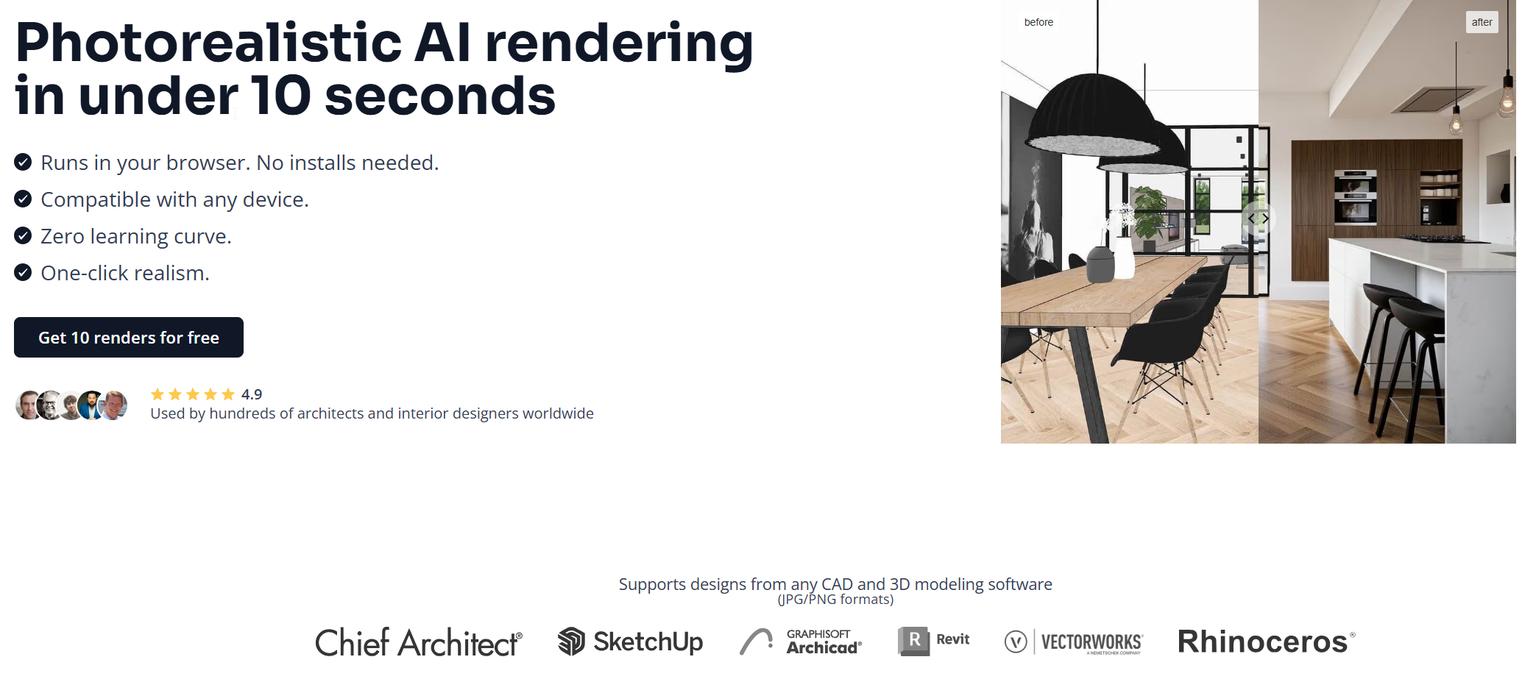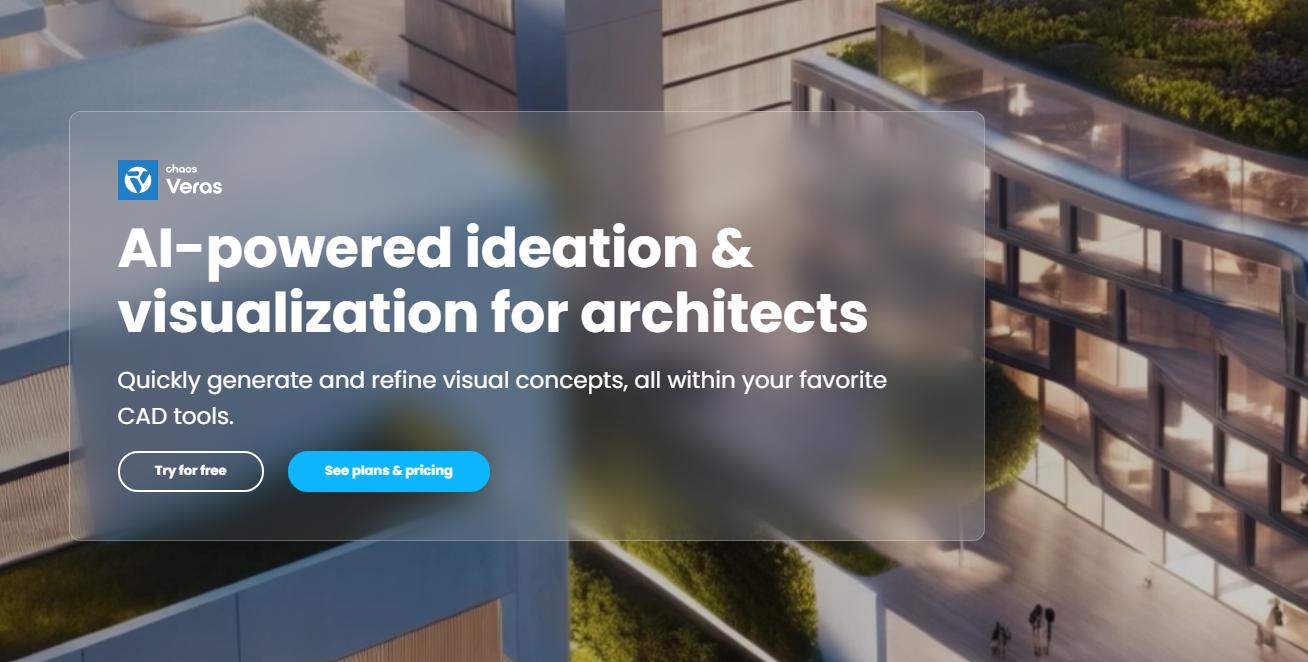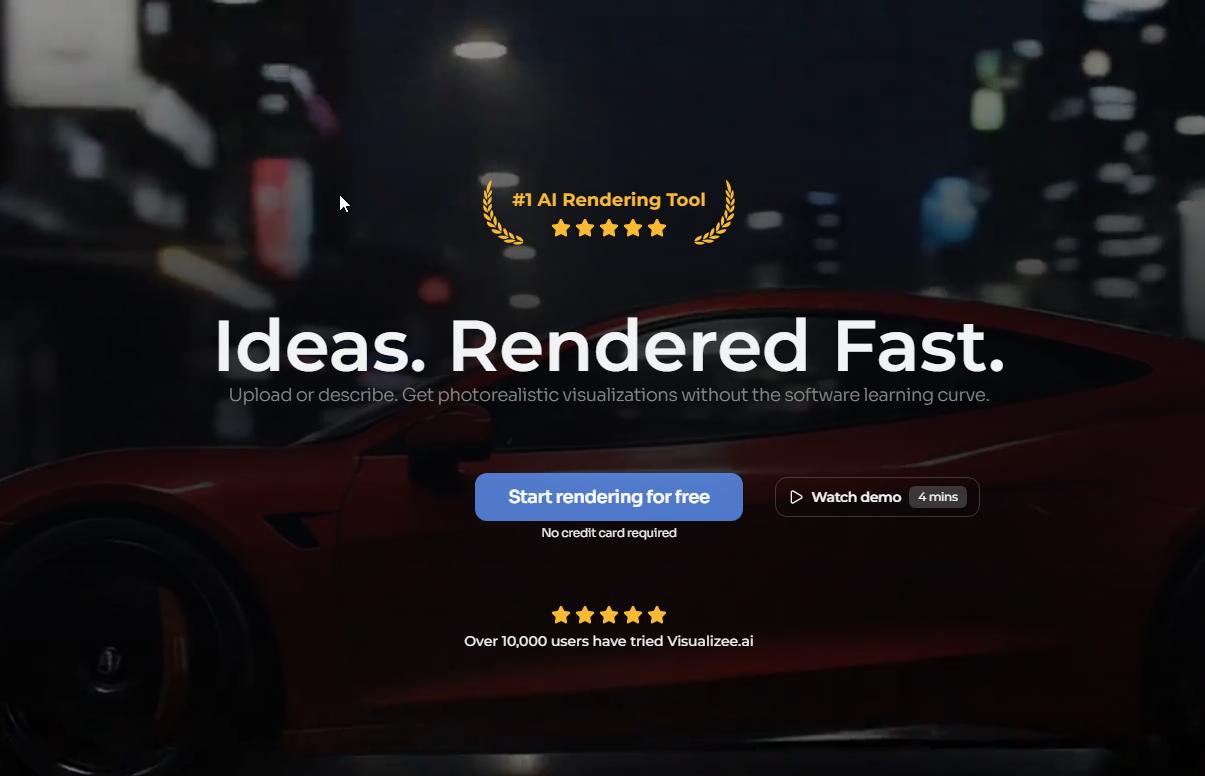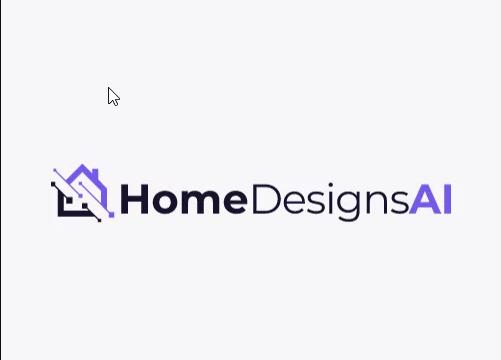10 min. reading
Juliy Cherevko
CEO paintit.ai

The integration of Artificial Intelligence has fundamentally changed how architects and designers approach visualization. Platforms like mnml.ai have set a high benchmark, offering professional-grade tools for rapidly transforming sketches and 3D models into photorealistic imagery. With a powerful engine and features like the Render Enhancer AI for upscaling visuals up to 8K, mnml.ai has become a significant player and a key reference point for professionals in the AEC (Architecture, Engineering, and Construction) sector.
However, the market is rapidly evolving in 2025, driven by new funding rounds and strategic acquisitions. For professionals searching for viable mnml.ai alternatives, the choice is no longer singular. Powerful platforms now offer unique strategic advantages, including unlimited rendering volume, native BIM integration, or a seamless, commerce-focused design flow.
This comprehensive review will dissect the landscape, helping you determine which AI assistant best complements your professional rhythm. We will assess whether you need the sheer visualization power of mnml.ai or a more intuitive, commerce-oriented system like Paintit.ai to accelerate your project pipeline.
To provide a fair comparison of mnml.ai alternatives, we use a rubric based on the core needs of AEC professionals:
Prompt Understanding (Coherency): How effectively the tool interprets complex, nuanced text prompts and translates them into architecturally sound and realistic concepts.
Iteration Flow (Friction): The speed and ease of making quick changes (adjusting materials, lighting, or style) without losing the original design context or requiring complex re-modeling.
Edit Depth (Control): The availability of advanced features like object-level editing, masking, high-resolution upscaling (e.g., 8K), and the ability to control the underlying model geometry.
Pricing & Value (Clarity): The transparency and predictability of the pricing model (credit-based vs. unlimited subscriptions), commercial licensing, and the overall value provided for the cost.
Integration and Commerce (Actionability): The platform's ability to fit into a larger professional or commercial workflow, including API offerings, BIM integration, and the capacity to link visualizations to purchasable products (SKUs).

Best for: Interior designers, real estate agents prioritizing virtual staging, and e-commerce platforms focused on turning visualization into actionable sales.
Paintit.ai is a strategic complement, rather than a direct competitor, to mnml.ai because its focus is not on rendering complex architectural geometry but on interior styling, rapid iteration, and commerce integration. Guided by the EIS framework (Empathy, Intuitiveness, Seamlessness), Paintit.ai presents itself as a human-centric design partner.
Core Strengths & Value:
Empathy & Intuitiveness: The workflow skips complex 3D modeling, starting with a simple photo upload or a text prompt. Edits are made using a conversational AI interface or on-image tools (controls directly on the visual).
Seamlessness & Commerce: The defining advantage is its ability to suggest real furniture recommendations (SKUs), bridging the gap between digital design and real-world procurement.
Edit Depth: The platform supports both Whole-Image transforms (global redesigns) and Targeted refinements (object-level edits like replacement or addition).
Value Proposition: Offers a single, all-in-one subscription that includes the full design ecosystem and integrated commerce tools. Subscriptions include a Weekly plan and a Monthly plan, both with a money-back guarantee.
🎨 Ready to transform your design visualization into a purchase-ready blueprint? Experience how Paintit.ai guides you from idea to buy with an intuitive and seamless flow. [Internal Link: Paintit.ai/try-monthly-plan → /pricing-plans]

Best for: Architectural firms and designers focused on high-volume conceptual ideation and maximizing design options quickly and affordably.
MyArchitectAI directly challenges the credit-based system of mnml.ai by offering an Unlimited Rendering model. The Pro plan, priced around $29 per month, grants a single user unlimited renders at 4K quality with a commercial license, eliminating the need to budget iterations. This price predictability is a game-changer during the early schematic phase where hundreds of test renders may be required.
Strengths:
Unlimited Volume: Offers unmatched capacity for rapid conceptual testing without the financial constraint of credits.
Price Predictability: A fixed monthly fee eliminates operational friction in budgeting visualization costs.
Speed: Generates photorealistic visuals from exported model images (JPG/PNG) in approximately 10 seconds.
Limitations:
Max Resolution: Currently lacks mnml.ai's high-end 8K upscaling.
Feature Breadth: Does not offer the specialized production features (AI Video Maker, MasterplanAI) found in mnml.ai.

Best for: Architects and engineers deeply embedded in the BIM workflow (Revit, Rhino, SketchUp) who require AI iteration to directly inform the underlying model geometry.
Veras operates as a plugin, integrated directly within popular 3D and BIM environments. This direct integration significantly reduces the friction of exporting images, which is typical of post-processing tools like mnml.ai.
Strengths:
Native BIM Flow: Rendering and refinement occur seamlessly within the native 3D modeling environment.
Geometry Control: Features the Geometry Override Slider, which allows users to balance the AI's creative output against the constraints of the modeled geometry.
Pricing Alignment: Adopts a fixed-cost, seat-based license model (approx. $59 per month per user), aligning with traditional AEC software licensing.
Limitations:
Cost: A higher fixed price per seat compared to other subscription models.
Dependence: Primarily valuable for users committed to specific BIM platforms (Revit, Rhino).

Best for: Professionals who need high-resolution 4K output and a large credit volume, but find mnml.ai's pricing or feature set less optimal for their specific needs.
Visualizee.ai is a close feature competitor to mnml.ai, supporting sketch-to-render, inpainting, and video generation. Its main competitive angle is providing a much larger volume of credits for a slightly higher cost than mnml.ai's lower tiers.
Strengths:
Aggressive Credit Scaling: The Pro plan (approx. $35/month) includes 19,250 credits, enough for hundreds of high-quality renders.
Feature Parity: Offers strong visualization tools, including upscaling up to 4K.
Limitations:
Credit Model: Still necessitates careful usage budgeting, unlike MyArchitectAI.
No 8K Upscaling: Maximum output is 4K resolution.

Best for: Homeowners, small businesses, and professionals who need a vast array of editing and redesign modes beyond basic style transfer (e.g., color/texture swap, object detection).
HomeDesigns AI markets itself as the world's #1 home design AI, claiming over 2 million users worldwide. The platform is focused on feature variety and community growth, offering over 80 design styles and 80+ space types.
Strengths:
Tool Variety: Includes unique modes like Color Swap, Texture Swap, Fill Spaces, AI Object Detection, and links to furniture shopping.
Growth & Traction: Surpassed 2 million users in mid-2025, suggesting strong community adoption.
Pricing Flexibility: Offers an Individual Plan (approx. $27/month, or $12/month when billed yearly) for 100 designs/month.
Limitations:
UX Friction: Pricing information is sometimes shown as images, which can impede transparency.
Onboarding: Some users report that the overwhelming number of options and modes requires a learning curve.
The decision between these mnml.ai alternatives often hinges on which stage of the design project you are currently focused on.
Mnml.ai: Focused on Production and Final Polish
The mnml.ai workflow is geared towards transforming a ready or near-ready 3D model into a high-quality marketing asset. Its value lies in specialized production features like Render Enhancer AI and AI Video Maker, which polish existing high-fidelity renders for client presentations or marketing collateral. It is the tool for the "final touch."
Paintit.ai: Focused on Instant Iteration and Sourcing
Paintit.ai's flow is built for the conceptual and procurement stages. By using a photo-based, conversational interface, it allows for instant style exploration and client sign-off. The critical path is its commercial intent: linking the aesthetic concepts directly to shoppable real furniture, dramatically accelerating the transition from digital design to physical purchase.
Veras: Focused on Model-Driven Design Development
Veras is the efficiency choice. Its unified flow means that visual feedback from the AI directly informs the underlying BIM model geometry. This is essential during the Design Development phase, where visualization acts as a rapid feedback loop for structural and spatial decisions, not just a rendering tool.
| Tool | Model | Max Resolution | Pro Plan Price (Monthly/Yearly) | Value Prop | Source (Date) |
| Paintit.ai | Subscription/Tokens | 4K | ~$24.99/mo | Shoppable output, All-in-one ecosystem | Internal (Sep 2025) |
| Mnml.ai | Subscription/Credits | 8K | ~$39/mo (~$32.5/mo yearly) | Production-ready features (8K, Video) | External (Sep 2025) |
| MyArchitectAI | Fixed Subscription | 4K | $29/mo ($249/yr) | Unlimited 4K renders | External (Sep 2025) |
| Veras (Chaos) | Fixed Seat License | 4K | $59/mo (Per Seat) | Native BIM workflow integration | External (Sep 2025) |
| HomeDesigns AI | Subscription/Designs | 4K | $27/mo ($12/mo yearly) | 80+ styles, 100 designs/mo | Public Page (Sep 2025) |
| VirtualStaging AI | Subscription/Photos | 4K | $19/mo (20 photos/mo) | Virtual staging compliance (MLS) | Public Page (Sep 2025) |
| REimagine Home | Subscription/Credits | 4K | $29/mo (Optimal) | Multi-tool breadth (Staging + Renovations) | Public Page (Sep 2025) |
| Criteria (1-5, 5=Best) | Paintit.ai | Mnml.ai | MyArchitectAI | Veras (BIM) | HomeDesigns AI |
| Prompt Understanding | 5 | 4 | 3 | 4 | 3 |
| Iteration Flow | 5 | 4 | 3 | 4 | 3 |
| Edit Depth (Object-Level) | 5 | 4 | 3 | 4 | 4 |
| Furniture/Commerce (SKU) | 5 | 2 | 2 | 2 | 3 |
| Pricing & Value (Volume) | 4 | 3 | 5 | 4 | 4 |
| BIM Integration (Native) | 2 | 3 | 2 | 5 | 2 |
| Max Output Resolution | 4K | 8K | 4K | 4K | 4K |
The best mnml AI alternative is the one that minimizes friction in your unique workflow.
Choose MyArchitectAI if your primary need is unlimited volume and low cost for conceptual exploration. The predictability of a fixed monthly fee for unlimited 4K renders is unbeatable for high-frequency testing.
Choose Veras if you are a professional architect whose work is centered on BIM/CAD. The native integration and geometry control are essential for ensuring that your AI-driven ideas are structurally sound and model-accurate.
Choose Paintit.ai if you are an interior designer, realtor, or e-commerce partner. Paintit.ai is designed to accelerate the final stages of the project by combining visualization with direct real furniture suggestions, creating a seamless path from idea to buy. If you value an all-in-one, emotionally resonant, and action-oriented ecosystem, choose Paintit.ai.
Choose HomeDesigns AI if you are a homeowner or small business that needs a huge variety of styles, design modes (like texture swap or object detection), and a high volume of monthly designs.
Mnml.ai remains a powerful choice for high-end Production Visualization, particularly for its advanced 8K upscaling and video features. However, the market has segmented, pushing users toward specialized mnml.ai alternatives that offer superior price predictability or deeper workflow efficiency where it matters most.
While most platforms offer a free tier (e.g., mnml.ai's 30 credits or REimagine Home's 5 free generations), the experience varies. Paintit.ai offers a money-back guarantee on its monthly and weekly plans, providing a risk-free way to test the full feature set.
Tools explicitly built for the real estate market, such as Virtual Staging AI and Collov AI, focus on MLS compliance and offer decluttering tools. Paintit.ai is also highly effective for virtual staging, with the added benefit of linking the staged room to real furniture.
Mnml.ai is strong in this area with its dedicated Exterior AI and Landscape AI tools. While Paintit.ai's core strength is interior design and commerce, the Adaptive scenarios pillar of its product architecture suggests support for various environments, which we are expanding.
Many of the best mnml.ai alternatives offer API or white-label solutions for business integration. ApplyDesign.io launched a public API in Jan 2025, Collov AI provides a comprehensive API center, and Paintit.ai has APIs and embeds on its B2B roadmap.
Paintit.ai's primary competitive advantage is the integration of its entire ecosystem-from nuanced prompt interpretation to real-world commerce integration-within a single, all-in-one subscription. This eliminates tab-hopping and moves the user from visualization to an actionable solution.

7 min read
Is your brand ready for autonomous AI buyers? Discover the 2025 roadmap, MCP integration, and how to partner with Paintit.ai for zero-click sales. Read now
Juliy Cherevko
CEO paintit.ai

10 min read
What is asymmetrical balance in interior design? Discover practical tips for living rooms and bedrooms to create harmony without symmetry. Read more
Juliy Cherevko
CEO paintit.ai

10 min read
Looking for an mnml.ai alternative? We compare the best AI tools for architects and designers: from 8K rendering and BIM integration to unlimited plans. Find your ideal design flow
Juliy Cherevko
CEO paintit.ai

9 min read
Transform your space with our expert guide to living room wall design. Discover 20+ simple decor ideas, highlight wall strategies, and technical rules for art placement
Juliy Cherevko
CEO paintit.ai

7 min read
Analysis of the best RoomGPT Alternatives. Discover why Decoratly, Spacely AI, and Paintit.ai outperform the competition with superior accuracy and hybrid monetization. Choose your tool
Juliy Cherevko
CEO paintit.ai

9 min read
Agentic AI Commerce is here. Discover how autonomous AI agents are moving interior design from "mood board" to "project realized" and what it means for you.
Juliy Cherevko
CEO paintit.ai